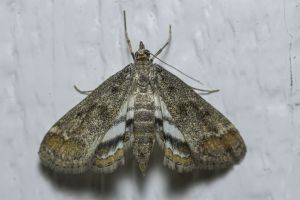

 +2Kontinente:EUNA
+2Kontinente:EUNA1. Lebendfotos
1.1. Falter
2. Diagnose
2.1. Erstbeschreibung
3. Biologie
3.1. Nahrung der Raupe
- [Hydrocharitaceae:] Vallisneria neotropicalis ? (Amerikanische Wasserschraube, Amerikanische Sumpfschraube ?)
- [Potamogetonaceae:] Potamogeton ? (Laichkraut ?)
- [Nymphaeaceae:] Nuphar sp. (Teichrose ?)
[bugguide.net (abgefragt 12. November 2020)] stellt zusammen: "larvae feed on eelgrass (Vallisneria, pondweed (Potamogeton), yellow waterlily (Nuphar), and other aquatic plants". Primärangaben sind mir noch nicht bekannt.
4. Weitere Informationen
4.1. Andere Kombinationen
- Oligostigma obscuralis Grote, 1881 [Originalkombination]
4.2. Faunistik
Die Art ist nicht in Europa heimisch! Goater (1986) schreibt: "P. obscuralis was the first of the aquatic greenhouse adventives to be reported in Britain, from a nursery in Hemel Hempstead, Hertfordshire, in 1967; subsequently found at Enfield in 1984; introduced with water-weeds from Maryland, U.S.A." Goater et al. (2005) erwähnen sie im "Appendix: List of acentropine species introduced to Europe by man" mit dem kurzen Text: "Recorded from Great Britain by Shaffer (1968a). Native to the Nearctic Region." Wie ein Blick in die Punktkarte der [North American Moth Photographers Group] zeigt, ist die Art im Osten der USA weit verbreitet (von Florida bis Main und Minnesota). Damit ist keineswegs auszuschließen, dass sie sich bei weiteren Einschleppungen auch in Europa festsetzen könnte.
Agassiz et al. (2013: 112) führen die Art bei den "adventive species" und schreiben zu England: "Occasionally imported with aquatic plants, only survives in heated greenhouses. Nearctic."
(Autor: Erwin Rennwald)
4.3. Typenmaterial
Shaffer (1968: 107): “Grote's description of the soecies was based on two female specimens, one from New York, the other from Wisconsin. The moths are in the collection of the British Museum (Natural History) and were both named and labelled al “types” by Grote, but he made no type designation in the original description. From the syntype series I therefore select the female specimen from New York as the lectotype. The remaining Wisconsin specimen, which has the abdomen missing, becomes a paralectotype.
Lectotype ♀, N. Y., Oligostigma obscuralis Grote, Type.
Paralectotype ♀. Wis., Sept., Oligostigma obscuralis Grote, Type.”
4.4. Literatur
- Agassiz, D.J.L., Beavan, S.D. & R.J. Heckford (2013): Checklist of the Lepidoptera of the British Isles. - Royal Entomological Society. 206pp.
- Goater, B. (1986): British Pyralid Moths. A guide to their identification. — 1-175 + 8 colour plates (Colchester: Harley Books).
- Goater, B., Nuss, M. & Speidel, W. (2005): Pyraloidea I (Crambidae: Acentropinae, Evergestinae, Heliothelinae, Schoenobiinae, Scopariinae). - In: Huemer, P. & Karsholt, O. (Hrsg.): Microlepidoptera of Europe 4: 1-304.
- Erstbeschreibung: Grote, A. R. (1881): New Pyralidæ. — Papilio 1 (2): 15-19. New York.
- Lectotypus-Festlegung: Shaffer, M. (1968): Illustrated notes on Parapoynx obscuralis (Grote) and Hellula undalis (Fabricius), two species new to the British List (Lepidoptera: Pyralidae). — Entomologist's Gazette 19: 107-112, pl. 7.





